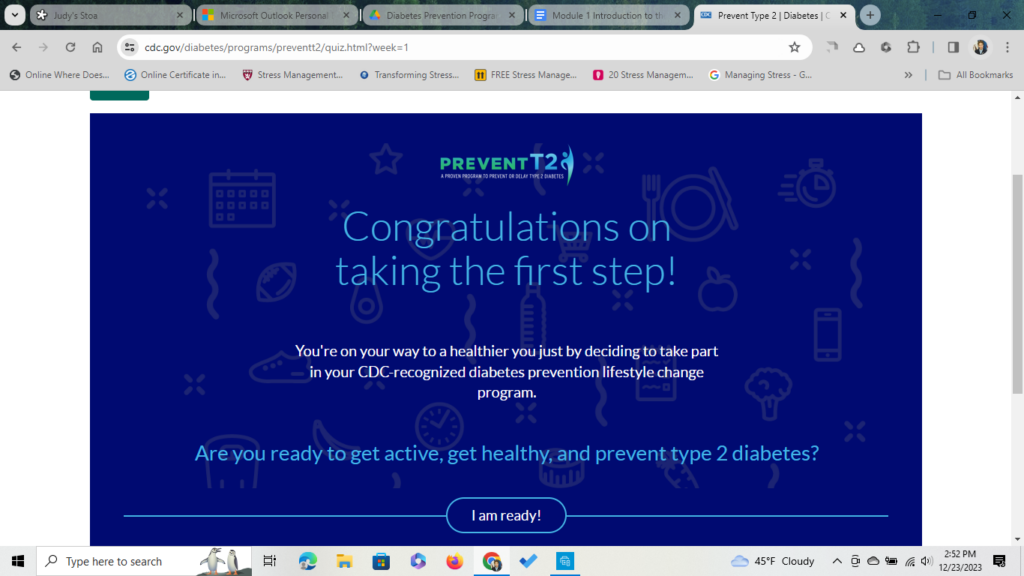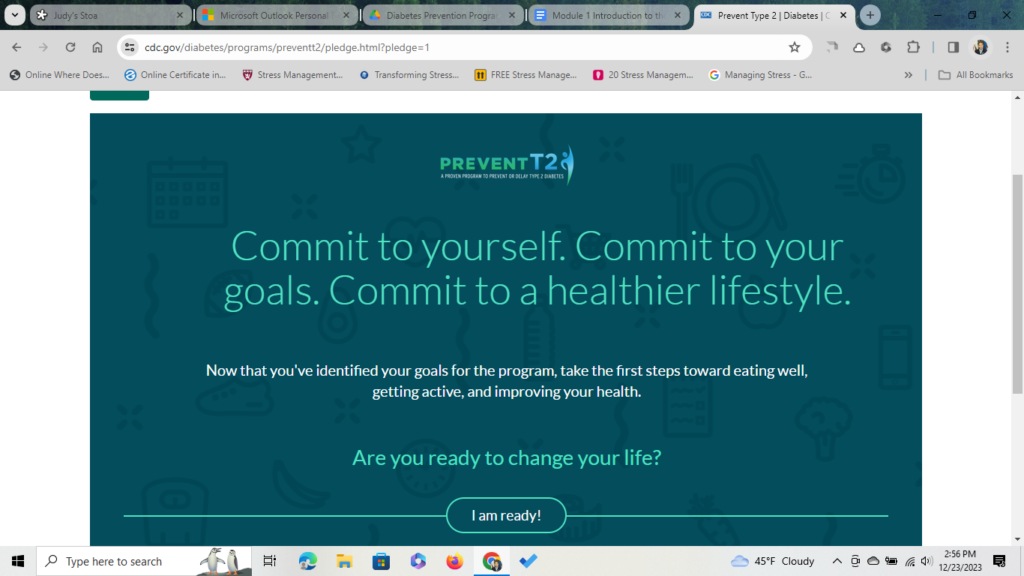Session Focus
In this session, we will talk about:
- The program’s goals and structure
- The basics of type 2 diabetes
- How to make your first action plan
- Setting your six month goals
Program Overview
Prediabetes
Prediabetes means that your blood sugar is higher than normal. But its not nigh enough for type 2 diabetes.
- More than 1 in 3 American adults has prediabetes.
- Nine out of 10 people with prediabetes don’t know they have it.
If you have prediabetes, you are more likely to:
- Get diabetes
- Get heart disease
- Experience a stroke
The good news is that losing weight and being active can cut your risk of type 2 diabetes in half.
What are some of the benefits to you of losing weight and staying in good health?
Source: Centers for Disease Control and Prevention
Prevent T2 Goals
Prevent T2 is a yearlong program. It’s designed for people with prediabetes. It’s also for people who are at high risk for type 2 diabetes.
Prevent T2 Program Goals
By the end of the first six months, the T2 Program goals are to:
- Lose at least 5 percent of your starting weight.
- Lose at least 4 percent of your starting weight and log an average of 150 of activity per week, OR
- Lower your HbA1C by 0.2 percent.
By the end of the second 6 months, program goals are to:
- Keep off the weight you’ve lost.
- Keep working toward your weight or HbA1C Goals, if you haven’t reached them
- Lose more weight if you wish, but no more than 1 to 2 pounds a week
- Keep getting at least 150 minutes of activity each week
All About A1C
You can learn more about HbA1C by visiting the CDC’s All About Your A1C web page.
Losing weight can:
- Prevent or delay type 2 diabetes
- Ease sleep problems
- Lower your blood pressure and cholesterol level
- Make you feel better about yourself
Getting more active can:
- Prevent or delay type 2 diabetes
- Give you more energy
- Help you sleep better
- Improve your memory, balance, and flexibility
- Lift your mood
- Lower your blood pressure and cholesterol
- Lower your risk of heart attack and stroke
- Lower your stress level
- Strengthen your muscles and bones
Alina’s Story
Alina Nguyen was not expecting to hear from her doctor that she was in danger of developing type 2 diabetes. She felt scared. However, when she learned that she could join a program to help her take charge of her health and lower her risk for type 2 diabetes, she was relieved.
That relief quickly faded as she began to feel overwhelmed thinking about the changes she would have to make. How would she fit exercise into her busy schedule? How could she afford to buy fresh fruits and vegetables making minimum wage? How would she be able to eat and fit in at family gatherings if she must eat differently? These efforts seemed almost impossible.
After joining the program, she began to see that there were in fact changes that she could make to her lifestyle and that she could stick to and were realistic. Alina learned that adopting small, positive changes in her day-to-day life was achievable, and that although the larger goal can seem far-off at times, taking small steps keeps her on the right path.
For example, because of Alina’s busy schedule, she continues to make small steps in physical activity for her goal. At first, she began with 15 minutes of brisk walking every other day. Now, she jogs during those 15 minutes and does 1 set of pushups in the evening. She also learned that using canned or frozen vegetables in her meals is a step she can afford.
Finally, Alina learned to adapt her eating patterns at family gatherings so she can enjoy the foods she loves and participate with family. For her, smaller meals lead to big results! As Alina began to see her success, her motivation and confidence climbed, and she knew she could stay in it for the long haul.
Program Structure
Program Handouts
Before
- Action Plan Journal
- Activity Log
- Food Log
- Weight Log
- Program Meeting Schedule
- To Learn More
Before each session, you will meet with your coach to provide your current weight and discussion any questions or needs you have.
Starting in a couple of weeks, you’ll also share your activity log with your coach. This log will help you track your total minutes of activity each week.
Your coach will keep a record of your weight and activity minutes, and so will you. This will track your progress.
During group time we will talk about how to:
- Eat well
- Be active
- Change your lifestyle
It can be challenging to change your lifestyle. But we’ll work through those challenges together. You’ll also have the chance to share your thoughts, feelings, and experiences–but only if you want to.
Personal Success Tool (PST) Modules
The Personal Success Tool (PST) modules are on the National Diabetes Prevention Program website. These Modules are interactive motivational tools to help you keep what you learned fresh in your mind. They will also help you apply what you’ve learned in your daily life, bringing your changes and progress into reality.
These modules are fun and include videos, quizzes, games, and other resources that will help you along your journey. You can complete the modules on a computer, smartphone, tablet, or any other device with internet access.
After completing some of your sessions, you will be encouraged to complete a module to help you build on what you have learned.
You can view the Personal Success Tool – Participant Overview handout for more information.
Basics of Type 2 Diabetes
When you eat, your body breaks down food into glucose, a type of sugar.
In people without type 2 diabetes, a hormone called insulin helps sugar leave the blood and enter the cells. This gives the cells energy.
In people with type 2 diabetes, the body doesn’t make or use insulin well. So, sugar builds up in the blood instead of going into the cells. And the cells don’t get enough energy.
Type 2 diabetes can harm your:
- Heart and blood vessels, which can lead to heart attacks and strokes
- Nerves
- Kidneys, which can lead to kidney failure
- Eyes, which can lead to blindness
- Feet, which can lead to amputation
- Gums
- Skin
You are more likely to get type 2 diabetes if you:
- Are too heavy (overweight or obese)
- Spend a lot of time sitting or laying down
- Have a parent or sibling with type 2 diabetes
- Are African American, Hispanic, Native American, or Asian American
- Are 45 or older. This may be because people tend to be less active and gain weight as they age. But type 2 diabetes is also on the rise among young people.
- Had diabetes while you were pregnant (gestational diabetes).
Your 6-Month Goals
Here are my personal goals for the Prevent T2 program:
In the next 6 months, I will get at least 150 minutes of activity each week at a medium or moderate pace or more.
Weight Goal:
I weigh pounds.
In the next 6-months, I will:
Lose at least (4/5/6/7) percent of my starting weight.
Lose at least pounds.
Reach pounds.
Weight Loss by the Numbers
One goal of this program is to lose at least 4 to 5 percent of your starting weight in the next 6 months. For instance, if you weighed 200 pounds, you would lose 8 to 10 pounds. The chart on the next two pages shows how many pounds you need to lose in order to reach your goal. To use the chart:
- Place your finger at the top of the blue column that says “Wt.” This stands for your starting weight. Move your finger down until you find the number of pounds you weigh now.
- Move your finger to the right. Stop when you reach the column that shows what percentage (4%, 5%, 6%, or 7%) of your starting weight you want to lose.
- Look at the number in the white box your finger is pointing to. That’s the number of pounds you need to lose in order to reach your goal.
Plan for Success
Commit to Change Module and Personalized Pledge
This “Commit to Change” module highlights today’s concepts and has testimonial videos and information about the programs ability to help you succeed. It ends with a pledge that you can create with your own personal goals and then sign and print.
Commit to Change Module


www.cdc.gov/diabetes/programs/preventt2/plendge.html?pledge=1
